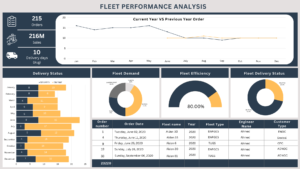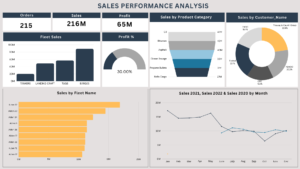Navigating the vast and complex seas of maritime logistics presents a myriad of challenges, and in this era of digital transformation, the role of data analytics has become paramount. This article delves into the innovative solutions and key aspects of the Techmax Technologies Shipping Analysis Dashboard, showcasing how data analytics is revolutionizing maritime logistics. From route optimization to predictive maintenance and overall operational improvement, the integration of advanced algorithms and real-time data empowers shipping companies with comprehensive insights for informed decision-making, cost savings, and environmental responsibility. Join us on a journey through the waves of technology as we explore the profound impact of data analytics on route efficiency, maintenance strategies, and the holistic improvement of operational processes in the dynamic realm of global shipping.
Route Optimization:
One of the critical challenges in maritime logistics is finding the most efficient routes for vessels. Data analytics plays a pivotal role in optimizing these routes, ensuring that ships reach their destinations in the most time and cost-effective manner. Advanced algorithms analyze historical data, weather patterns, sea currents, and real-time information to calculate optimal routes, taking into account fuel consumption, weather conditions, and potential disruptions.
Benefits of Route Optimization through Data Analytics:
- Fuel Efficiency: By identifying the most fuel-efficient routes, shipping companies can significantly reduce fuel consumption, leading to both cost savings and a smaller environmental footprint.
- Timely Deliveries: Predictive analytics helps anticipate delays and choose alternative routes, ensuring that goods reach their destination on time even in the face of unforeseen challenges.
- Risk Mitigation: Data analytics can assess the risk of piracy, adverse weather, or geopolitical instability along different routes, enabling companies to make informed decisions to safeguard both cargo and crew.
Predictive Maintenance:
Ensuring the seaworthiness of vessels is paramount for maritime logistics. Predictive maintenance, empowered by data analytics, has emerged as a game-changer in this regard. By analyzing data from sensors and monitoring equipment on board, shipping companies can predict when equipment is likely to fail, allowing for proactive maintenance interventions.
Key Aspects of Predictive Maintenance in Maritime Logistics:
- Condition Monitoring: Sensors on ships continuously collect data on the condition of critical components such as engines, propellers, and navigation systems. Data analytics interprets this information to identify patterns indicative of potential failures.
- Reduced Downtime: Anticipating maintenance needs allows companies to schedule repairs during planned stops, minimizing unplanned downtime and disruptions to shipping schedules.
- Cost Savings: Predictive maintenance not only reduces repair costs but also extends the lifespan of equipment by addressing issues before they escalate, leading to long-term savings.
Overall Operational Improvement:
Beyond route optimization and maintenance, data analytics contributes to overall operational improvement in maritime logistics. From port operations to inventory management, leveraging data helps streamline processes and enhance decision-making.
Holistic Operational Improvement Through Data Analytics:
- Port Efficiency: Analyzing historical data and real-time information enables ports to optimize loading and unloading processes, reduce congestion, and enhance overall efficiency.
- Inventory Optimization: By analyzing demand patterns and historical consumption data, shipping companies can optimize their inventory levels, ensuring they have the right amount of stock on board to meet customer demands without excess carrying costs.
- Data-Driven Decision-Making: Executives and managers can make informed decisions by relying on data-driven insights, leading to improved resource allocation, risk management, and strategic planning.
Techmax Technologies Shipping Analysis Dashboard:
Innovations in data analytics have given rise to powerful tools such as the Techmax Technologies Shipping Analysis Dashboard, providing maritime logistics professionals with comprehensive insights and visualizations for informed decision-making.
Fleet Performance Analysis:
The Fleet Performance Analysis Sheet encompasses various key elements crucial for comprehensive logistics management. Firstly, it delves into the comparison of current and previous year order trends, shedding light on market dynamics and demand shifts. Real-time visualization of delivery status enables proactive measures for ensuring timely deliveries and maintaining high customer satisfaction. Insights into fleet demand patterns allow for strategic resource planning and optimization of fleet size based on market requirements. Evaluating fleet efficiency through key performance indicators aids in identifying areas for improvement and achieving operational excellence. Additionally, tracking the delivery status of the entire fleet provides a comprehensive overview, facilitating effective logistics management. This integrated approach ensures a holistic understanding of fleet performance for informed decision-making and enhanced operational efficiency.

Sales Performance Sheet:
The Sales Performance Sheet provides a comprehensive analysis across various dimensions to enhance business decision-making. Firstly, it categorizes and scrutinizes sales performance by product category, offering valuable insights for effective inventory management and targeted marketing strategies. Secondly, it evaluates customer-specific sales data by Customer_Name, enabling personalized services, identification of high-value clients, and improved customer relationship management. The third aspect focuses on Fleet Sales, ensuring the optimization of sales strategies to align with overall business objectives. The sheet also incorporates Profit % calculations and visualizations, aiding in financial planning and performance assessment. Additionally, it delves into Sales by Fleet Name, providing insights for targeted improvements and resource allocation. Lastly, the breakdown of Sales for 2021, 2022, and 2020 by month enables a detailed exploration of seasonal trends, guiding future sales forecasting. Together, these dimensions offer a holistic view of sales performance, empowering strategic decision-making for sustained business growth.

In conclusion, the Techmax Technologies Shipping Analysis Dashboard exemplifies the integration of data analytics into maritime logistics, offering a comprehensive suite of tools for route optimization, predictive maintenance, and overall operational improvement. As the industry continues its digital transformation, such innovative solutions pave the way for enhanced efficiency, informed decision-making, and a competitive edge in the dynamic seas of global shipping.




